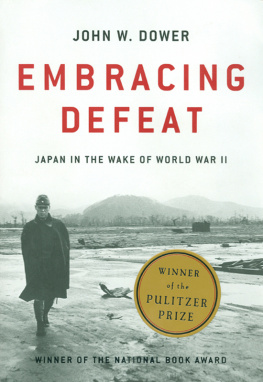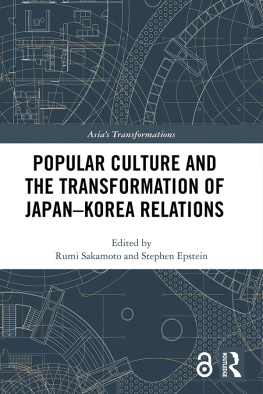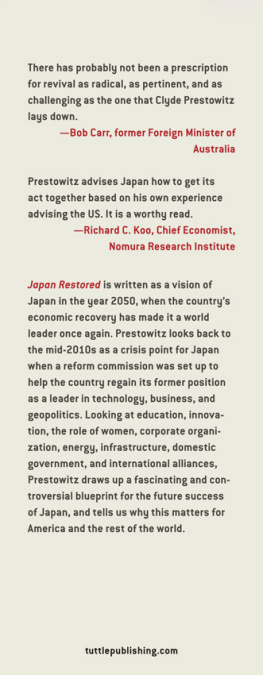1. E.H. Norman and the Uses of History is excerpted from the introduction to John W. Dower, ed., Origins of the Modern Japanese State: Selected Writings of E. H. Norman (Pantheon Books, 1975), 35, 8093. The full introduction in the original printing runs from pages 3 to 101.
2. This illustrated version of Race, Language, and War in Two Cultures: World War II in Asia appeared in Lewis A. Erenberg and Susan E. Hirsch, eds., The War in American Culture: Society and Consciousness During World War II (University of Chicago Press, 1996), 169201. [For copyright reasons, Figure 2-3 replaces an American newspaper cartoon that is no longer accessible.] An earlier version of this essay, without illustrations, appeared in Dower, Japan in War and Peace (The New Press, 1993).
3. Japans Beautiful Modern War appeared in a lavishly illustrated exhibition catalog edited by Jacqueline M. Atkins under the title Wearing Propaganda: Textiles on the Home Front in Japan, Britain, and the United States, 19311945 (Yale University Press, for The Bard Graduate Center for Studies in the Decorative Arts, Design, and Culture, 2005), 93113.
4. An Aptitude for Being Unloved: War and Memory in Japan appeared in Omer Bartov, Atina Grossmann, and Mary Nolan, eds., Crimes of War: Guilt and Denial in the Twentieth Century (The New Press, 2002), 21741, 31321.
5. The Bombed: Hiroshimas and Nagasakis in Japanese Memory originally appeared in a symposium published in Diplomatic History 19, no. 2 (Spring 1995): 27595. The symposium was subsequently reprinted as a book edited by Michael J. Hogan under the title Hiroshima in History and Memory (Cambridge University Press, 1996), 11642.
6. A Doctors Diary of Hiroshima, Fifty Years Later was written as a foreword to the fiftieth anniversary edition of Michihiko Hachiya, Hiroshima Diary: The Journal of a Japanese Physician, August 6September 30, 1945: Fifty Years Later (University of North Carolina Press, 1995), vxvii.
7. How a Genuine Democracy Should Celebrate Its Past appeared as an op-ed in the Chronicle of Higher Education, June 16, 1995.
8. Peace and Democracy in Two Systems: External Policy and Internal Conflict appeared in Andrew Gordon, ed., Postwar Japan as History (University of California Press, 1993), 333.
9. Mocking Misery: Grassroots Satire in Defeated Japan appeared in Gail Lee Bernstein, Andrew Gordon, and Kate Wildman Nakai, eds., Public Spheres, Private Lives in Modern Japan, 16001950 (Harvard University Asia Center, 2005), 34574. This volume was a Festschrift in honor of Professor Albert M. Craig.
10. Lessons from Japan about Wars Aftermath appeared as an op-ed in the New York Times, October 27, 2002.
11. The Other Japanese Occupation was published in The Nation, July 7, 2003. A revised excerpt from this, focusing on imperial Japans grand policy in China including Manchuria, was published in Stephen R. MacKinnon, Diana Lary, and Ezra F. Vogel, eds., China at War: Regions of China, 19371945 (Stanford University Press, 2007), 1721.
1. E.H. NORMAN, JAPAN, AND THE USES OF HISTORY
. James Morley, Introduction, in James Morley, ed., Dilemmas of Growth in Prewar Japan (Princeton University Press, 1972).
. Shlomo Avineri, Social and Political Thought of Karl Marx (Cambridge University Press, 1971), 65.
. Cf. Morley, Dilemmas of Growth in Prewar Japan, 12.
2. RACE, LANGUAGE, AND WAR IN TWO CULTURES:
WORLD WAR II IN ASIA
This chapter summarizes some of the themes developed at length in my War Without Mercy: Race and Power in the Pacific War (Pantheon Books, 1986), where extensive annotations can be found. Here I have focused in particular on racial language in comparative perspective.
. Answer to Japan, 20. This report appears in several archival collections at the Hoover Institution, Stanford University. Cf. Bonner Frank Fellers Collection, boxes 1 and 15; also U.S. Army Forces in the Pacific, Psychological Warfare Branch, box l.
. From Hinos 1942 book Btn Hant Kjki, as quoted in Haruko Taya Cook, Voices from the Front: Japanese War Literature, 19371945 (M.A. thesis in Asian Studies, University of California, Berkeley, 1984), 5960.
. I have addressed these themes in contemporary U.S.-Japan relations in greater detail in Japan in War and Peace (The New Press, 1993), 279335.
3. JAPANS BEAUTIFUL MODERN WAR
. Some of the themes concerning Japanese, American and British attitudes during the war that are touched on in this essay were introduced in John W. Dower, War Without Mercy: Race and Power in the Pacific War (Pantheon Books, 1986), and are reprised in chapter 2 in this present volume. Academic and polemical writings on the Rape of Nanking have proliferated in recent years. For a balanced overview of Chinese, Japanese, and English-language writings, see Daqing Yang, Convergence or Divergence? Recent Historical Writings on the Rape of Nanjing, American Historical Review (June 1999): 84265. See also Joshua A. Fogel, ed., The Nanking Massacre in History and Historiography (University of California Press, 2000), which also includes an essay by Yang.
. For general fatality estimates, see Dower, War Without Mercy, 293300. The Japanese figures would include more than 100,000 killed in successive air raids on Tokyo, beginning with the great attack of March 910, 1945; another 200,000 to 300,000 killed in the conventional firebombing of over 63 other Japanese cities that followed the first Tokyo air raid; more than 200,000 killed by the atomic bombing of Hiroshima (an estimated 140,000 dead) and Nagasaki (an estimated 75,000 dead); some 100,000 to 150,000 civilians killed in the Battle of Okinawa that ended in June 1945; and perhaps 100,000 civilians who perished attempting to return from Manchuria in the wake of Japans defeat.
. For an extended analysis of the cherry-blossom imagery, see Emiko Ohnuki-Tierney, Kamikaze, Cherry Blossoms, and Nationalism: The Militarization of Aesthetics in Japanese History (University of Chicago Press, 2002). The following song, popular among naval cadets and titled Cherry Blossoms of the Same Class, is quoted in ibid., 141: You and I are two cherry blossoms. We bloom in the shadow of a pile of sand bags; / Since we are flowers, we are doomed to fall. Let us fall magnificently for the country.... / You and I are two cherry blossoms. Even if we fall separately, / the capital of flowers is Yasukuni Shrine. We meet each other in the treetops in the spring.
. The full imperial rescripts announcing both the initiation and end of the war are reprinted in numerous sources. See, for example, the appendices in Edwin P. Hoyt, Japans War: The Great Pacific Conflict, 18531952 (Da Capo Press, 1986). Hoyt notes that the 1941 rescript was reprinted every month.
. For the full 1937 tract, see Japan Ministry of Education, Kokutai no Hongi: Cardinal Principles of the National Entity of Japan, trans. John O. Gauntlett and ed. Robert K. Hall (Harvard University Press, 1949). The 1940 Way of the Subject appears as an appendix in Otto D. Tolischus, Tokyo Record (Reynal & Hitchcock, 1943), 40527. Also of interest in this regard is Robert K. Hall, Shshin: The Ethics of a Defeated Nation (Columbia University Press, 1949). The Japanese cartoon is reproduced in Dower, War Without Mercy, 191.
. For a very explicit expression of this, see Nyozekan Hasegawa, Beautifying War, in the English-language magazine Nippon 16 (1938): 18ff. Hasegawa was a well-known Japanese cultural commentator.
. The Kyoto School of philosophers, which took its name from Kyoto Imperial University and was associated with the particularly influential ideas of Nishida Kitar, has attracted close scrutiny (and considerable controversy) in recent years concerning its intellectual contributions to the rise of nationalism and militarism in Japan. See James W. Heisig and John C. Maraldo, eds.,
Next page







